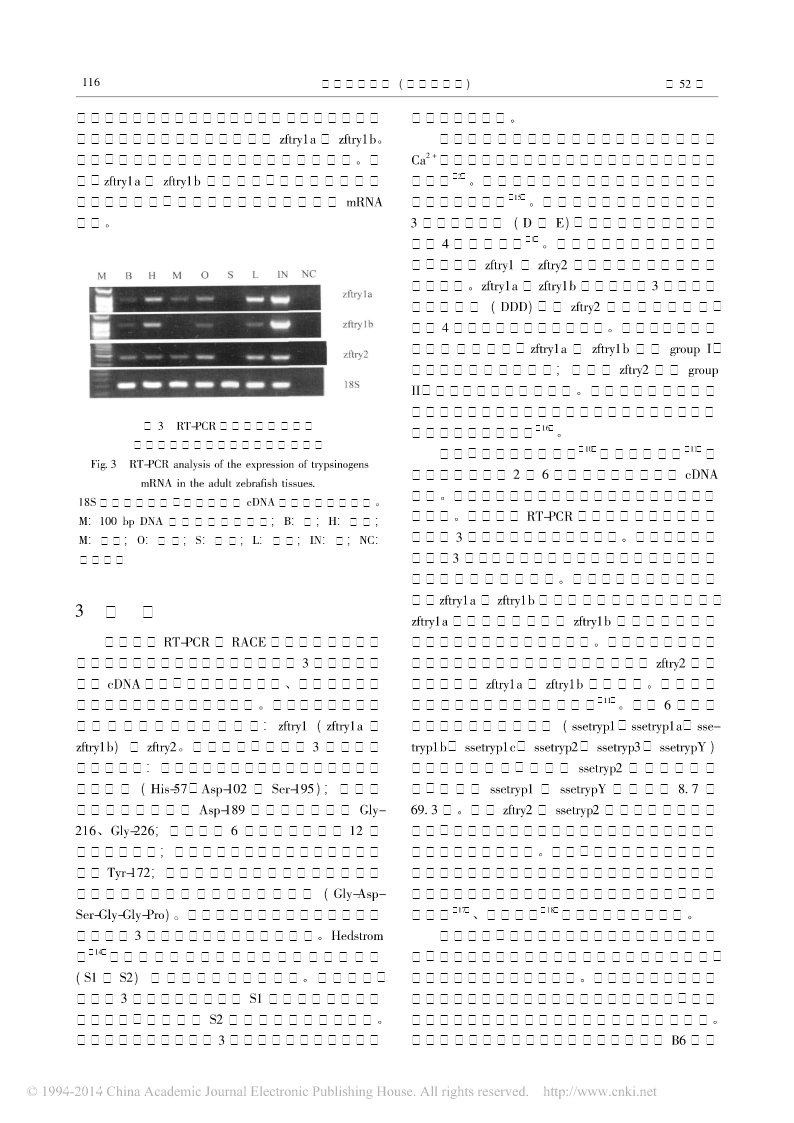
斑马鱼3种胰蛋白酶原基因的克隆_序列分析及组织表达.pdf

qw****27







在线预览结束,喜欢就下载吧,查找使用更方便
相关资料

斑马鱼3种胰蛋白酶原基因的克隆_序列分析及组织表达.pdf
第52卷第1期中山大学学报(自然科学版)Vol.52No.12013年1月ACTASCIENTIARUMNATURALIUMUNIVERSITATISSUNYATSENIJan.2013斑马鱼3种胰蛋白酶原基因的克隆、序列分析及组织表达*陈文波,李卫国,张珍,焦春磊,吴帆(河南理工大学资源环境学院,河南焦作454000)摘要:胰蛋白酶是丝氨酸蛋白酶类超家族成员之一,在动物蛋白消化中起着重要作用。为深入研究胰蛋白酶在鱼类中的蛋白结构和生理功能,利用RT-PCR和RACE方法,成功获得了斑马鱼3种胰蛋白酶原c

川芎COMT基因序列的克隆、分析、表达及功能鉴定的中期报告.docx
川芎COMT基因序列的克隆、分析、表达及功能鉴定的中期报告根据项目要求,我们进行了川芎(COMT)基因的克隆、分析、表达及功能鉴定的中期报告,以下是我们的主要工作和进展情况:1.基因克隆我们首先设计合适的引物,利用RT-PCR技术从川芎植物中克隆得到了COMT基因的全长序列,该序列长度为1176bp,编码391个氨基酸残基。2.序列分析我们对COMT基因的序列进行了分析,包括启动子、开放阅读框、保守结构域、信号肽等,发现该基因具有典型的COMT基因家族结构特点。3.表达载体构建为了在细胞中表达COMT蛋白

斑马鱼精巢单细胞转录组分析及银鲫nanos2基因的克隆与表达的开题报告.docx
斑马鱼精巢单细胞转录组分析及银鲫nanos2基因的克隆与表达的开题报告一、研究背景斑马鱼是一种广泛应用于模式生物学研究的实验动物,其短周期和明显显微分化特征,使其在遗传和发育生物学研究中成为重要的实验材料。斑马鱼不仅具有生物学价值,而且还被广泛用于药物筛选和疾病模型研究。因此,基于斑马鱼的研究已成为生命科学领域的热点。nanos2基因是斑马鱼中的一个关键发育基因,它的表达与性腺发育、性别决定等密切相关。然而,目前还没有关于斑马鱼nanos2基因的全面研究,尤其是其在单细胞水平转录组的表达情况。本研究将从这

猪胃肠炎病毒的分离鉴定及S基因的克隆、序列分析与原核表达的综述报告.docx
猪胃肠炎病毒的分离鉴定及S基因的克隆、序列分析与原核表达的综述报告猪胃肠炎病毒(Porcineepidemicdiarrheavirus,PEDV)是一种单链正链RNA病毒,属于科尔默科萨克病毒家族(Coronaviridaefamily)的科尔默病毒属(Coronavirusgenus),病毒颗粒为球形或卵圆形,直径约60-140nm,表面有刺状突起。该病毒主要引起猪的胃肠炎,导致腹泻、呕吐、食欲减退等症状,严重的可导致新生猪的死亡率高达80-100%。因此,PEDV对于猪场的经济和猪肉行业的稳定有着重

猪胸膜肺炎放线杆菌毒素ⅢA基因的克隆、序列分析及原核.pdf
!"卷"期微生物学报&’()!".’)"#$$"年%月!"#$%&"’()&(*(+&"$,&-&"$*+,-#$$"!!!!!!!!!!!!!!!!!!!!!!!!!!!!!!!!!!!!!!!!!!!!!!!!!!!!猪胸膜肺炎放线杆菌毒素!!基因的克隆、序列分析及原核表达陈汉阳刘军发何启盖肖少波陈焕春"(华中农业大学畜牧兽医学院动物病毒室武汉!"$$9$)摘要:因胸膜肺炎放线杆菌的致病性主要是由毒素决定的,故参照猪胸膜肺炎放线杆血清#型菌株的序列(J-,15,KL/#/!M)设计了一对特异性引物,用
